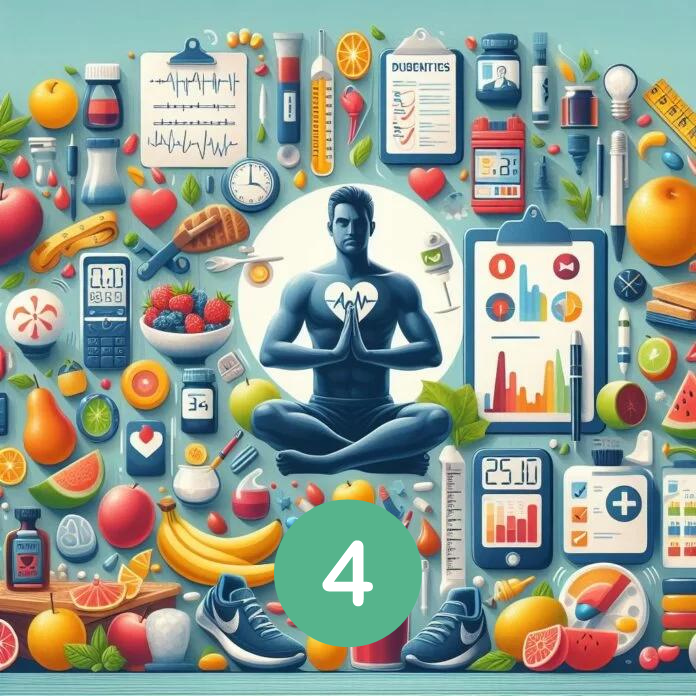Maintaining optimal blood sugar levels is crucial for overall health, particularly for those managing diabetes or at risk of developing it. Embracing healthy habits can significantly impact blood sugar management and improve quality of life.
This guide, focusing on essential habits 16 through 20, offers practical advice on making lifestyle changes that support blood sugar control. From avoiding sugary drinks to staying active, each habit provides a step towards a healthier, more balanced life.
16. Avoid Sugary Drinks:

The consumption of sugary drinks has been linked to numerous health issues, including type 2 diabetes, obesity, and heart disease. One of the immediate benefits of cutting out sugary beverages is the stabilization of blood sugar levels. In this article, we explore how avoiding these high-sugar drinks can help maintain your blood sugar within normal ranges, enhancing your overall health.
-Immediate Impact on Blood Sugar Levels: Sugary drinks, such as sodas, fruit punches, and energy drinks, contain high amounts of simple sugars like glucose, fructose, and sucrose. When consumed, these sugars are quickly absorbed into the bloodstream, causing a rapid spike in blood sugar levels. This spike can lead to increased insulin production, a hormone that helps cells absorb sugar from the blood. Over time, frequent spikes can lead to insulin resistance, a key factor in type 2 diabetes. By avoiding these drinks, you can prevent these dangerous spikes and keep your blood sugar levels more stable.
-Long-Term Benefits for Insulin Sensitivity: Regular consumption of high-sugar drinks can lead to chronic high blood sugar levels, which may decrease the body’s sensitivity to insulin. Without sugary drinks in your diet, your body can maintain better insulin sensitivity. This means your cells can more effectively use available insulin to absorb sugar from your bloodstream, keeping your blood sugar levels in a normal range.
-Alternative Hydration Options: Replacing sugary drinks with healthier alternatives is key. Water, herbal teas, and sparkling water with a slice of lemon or lime are excellent choices that contribute to hydration without affecting your blood sugar. Incorporating these drinks can help you avoid the empty calories and high sugars of sweetened beverages.
In summary, avoiding sugary drinks is a simple yet effective way to control your blood sugar levels. Not only does it help in maintaining energy levels throughout the day, but it also reduces the risk of diabetes and improves overall health. Start making healthier choices today to benefit your body and mind.
17. Read Labels Carefully:

Understanding food labels is crucial for maintaining healthy blood sugar levels. This article explains why paying close attention to ingredient lists and nutritional facts can help you identify hidden sugars and carbohydrates that could spike your blood sugar.
-Understanding Food Labels:
•Nutrition Facts Panel: Start by looking at the serving size and the amount of servings per container, as these will help you calculate the actual amount of sugars and carbohydrates you consume if you were to eat the whole package.
•Total Carbohydrates: Pay close attention to this section, which includes dietary fibers, sugars, and other carbohydrates. Fibers can help control blood sugar levels, whereas sugars can cause them to spike.
•Types of Sugars: Ingredients are listed in descending order of weight. Watch out for words like sucrose, glucose, high fructose corn syrup, and dextrose, which are all forms of sugar. Sometimes sugars are listed under different names, making them harder to recognize.
-Hidden Sugars and Carbohydrates:
•Multiple Names for Sugar: Be aware of the various names used for sugar, such as maltose, lactose, honey, and molasses. These can be hidden in foods that you might not typically consider as sweet, like bread, condiments, and salad dressings.
•No Added Sugar’ and ‘Sugar-Free’ Labels: These labels don’t necessarily mean the product is low in carbohydrates. Some ‘sugar-free’ products compensate for taste with additional carbohydrates that can still affect your blood sugar.
-Practical Tips for Grocery Shopping:
•Make Informed Choices: Use the information on labels to decide on the healthiest options. For example, choosing yogurt with natural ingredients and no added sugars over one that is non-fat but loaded with sweeteners.
•Plan Ahead: Knowing how to read labels can also help you plan your meals more effectively, ensuring a balanced intake of carbohydrates throughout the day to keep your blood sugar stable.
In summary, reading food labels is a simple yet effective strategy to manage your blood sugar levels. By becoming informed about hidden sugars and carbohydrates, you can make better dietary choices that contribute to a healthier lifestyle and prevent the complications associated with high blood sugar levels.
18. Cook at Home:

Cooking at home has numerous health benefits, including better control over the ingredients and portions of your meals, which is crucial for managing blood sugar levels. This article delves into how preparing your meals can lead to a healthier lifestyle and assist in keeping your blood sugar within a normal range.
-Complete Control Over Ingredients:
•Choice of Healthier Ingredients: When you cook at home, you decide what goes into your food. This means you can avoid hidden sugars and excessive carbohydrates that are common in processed and restaurant foods, which can spike your blood sugar.
•Use of Whole, Unprocessed Foods: Incorporating whole grains, lean proteins, and plenty of vegetables helps stabilize blood sugar levels. Home cooking allows you to include these nutrient-rich foods that are often absent in take-out or pre-packaged meals.
-Portion Control:
•Regulating Meal Sizes: Cooking at home lets you measure and control portion sizes according to your health needs, which is essential for blood sugar management.
Overeating, even healthy food, can lead to higher blood sugar levels.
•Understanding Food Quantities: By preparing your meals, you become more aware of typical serving sizes and the nutritional content of various foods, aiding in better diabetes management and weight control.
-Avoiding Unhealthy Cooking Methods:
•Choosing Healthier Cooking Techniques: Methods like grilling, baking, steaming, or sautéing require less oil and fat compared to frying. Reducing fat intake is important because high-fat diets can delay the digestion process, affecting blood sugar levels and insulin sensitivity.
•Reducing Salt and Sugar: You can tailor your recipes to use less salt and sugar, which not only helps in controlling blood sugar but also benefits overall health.
-Frequency and Regularity of Meals:
•Scheduling Meal Times: Eating at regular intervals is important for blood sugar control. Cooking at home allows you to schedule meals more effectively, avoiding long gaps or snacking, which can destabilize blood sugar levels.
In summary, cooking at home is a powerful way to influence your health positively, particularly for controlling and maintaining normal blood sugar levels. By managing what ingredients are used and how food is prepared, home-cooked meals can be tailored to meet your dietary needs and improve your overall well-being.
19. Limit Alcohol Consumption:

Alcohol has significant effects on blood sugar levels, which can complicate the management of diabetes and overall health. Understanding the impact of alcohol and how to consume it responsibly is key to maintaining healthy blood sugar levels. This article explores why moderation is critical and offers tips for safe alcohol consumption.
-Effects of Alcohol on Blood Sugar Levels:
•Immediate Impact: Alcohol can cause an initial increase in blood sugar due to its high sugar content in certain drinks. However, it can also lead to a sudden drop in blood sugar hours after drinking, especially if consumed on an empty stomach.
•Long-term Considerations: Regular heavy drinking can damage the liver, an organ crucial for glucose regulation. A compromised liver can lead to more volatile and less predictable blood sugar levels.
-Drinking in Moderation:
•Understanding Limits: For most adults, moderate alcohol consumption means up to one drink per day for women and up to two drinks per day for men. It’s important to adhere to these guidelines to minimize the impact on blood sugar levels.
•Choosing Lower-Sugar Options: Opt for drinks with less sugar, such as light beer, dry wines, or spirits mixed with water or club soda instead of sweetened mixers.
-Never Drink on an Empty Stomach:
•The Role of Food: Eating a balanced meal before drinking alcohol is crucial because food slows down the absorption of alcohol into the bloodstream, helping to prevent sharp drops in blood sugar.
•Best Foods to Eat: Include foods with healthy fats, protein, and complex carbohydrates, which can help maintain more stable blood sugar levels while drinking.
-Recognizing the Signs of Hypoglycemia:
Be Prepared: Alcohol can mask the symptoms of low blood sugar, which can be dangerous. It’s vital for individuals, especially those with diabetes, to recognize symptoms such as shakiness, confusion, and dizziness and know how to respond appropriately.
In summary, limiting alcohol consumption is crucial for anyone looking to maintain normal blood sugar levels. By understanding how alcohol affects blood sugar and following guidelines for moderate consumption, you can enjoy a healthier lifestyle without unnecessary risks.
20. Stay Active:

Regular physical activity is a cornerstone of health, particularly effective in regulating blood sugar levels. This article explores how incorporating exercise into your daily routine can help keep your blood sugar within a normal range and improve overall health.
-Benefits of Regular Exercise on Blood Sugar Levels:
•Enhances Insulin Sensitivity: Exercise increases the body’s sensitivity to insulin, helping to lower blood sugar levels naturally by promoting better glucose uptake into the cells.
•Immediate and Long-Term Effects: Physical activity not only helps lower blood sugar immediately following a workout but also contributes to long-term blood sugar management through improved fitness and weight loss.
-Types of Exercise to Consider:
•Aerobic Activities: Activities like walking, running, cycling, and swimming can be particularly effective in controlling blood sugar. These exercises help burn glucose for energy and increase heart rate, improving cardiovascular health.
•Resistance Training: Weight lifting and bodyweight exercises help build muscle mass, which is beneficial for blood sugar control as muscle cells use more glucose than fat cells.
-Incorporating Exercise into Daily Routine:
•Start Small: If you’re new to exercise, start with short periods of activity, such as a 10-minute walk after meals, gradually increasing the duration and intensity as your fitness improves.
•Regular Schedule: Aim for at least 150 minutes of moderate aerobic activity or 75 minutes of vigorous activity per week, as recommended by health guidelines.
-Monitor Your Blood Sugar Levels:
•Before and After Exercise: Monitoring your blood sugar before and after exercise can help you understand how your body reacts to different types of activities and adjust your routine to optimize blood sugar control.
•Adjusting Food and Medication: Depending on your blood sugar readings, you may need to adjust your food intake or medication before exercising to prevent low blood sugar levels (hypoglycemia).
In summary, staying active is essential for maintaining healthy blood sugar levels and overall health. By making exercise a regular part of your daily life, you can enhance your body’s ability to regulate glucose, reduce the risk of diabetes complications, and enjoy a higher quality of life.
Conclusion:
Adopting the habits discussed in this segment can lead to substantial improvements in blood sugar control and overall health. By understanding and implementing these practices, such as careful dietary choices, regular physical activity, and responsible alcohol consumption, individuals can enjoy a healthier lifestyle while reducing the risk of diabetes-related complications. Embrace these changes consistently for long-term benefits and a better quality of life.

